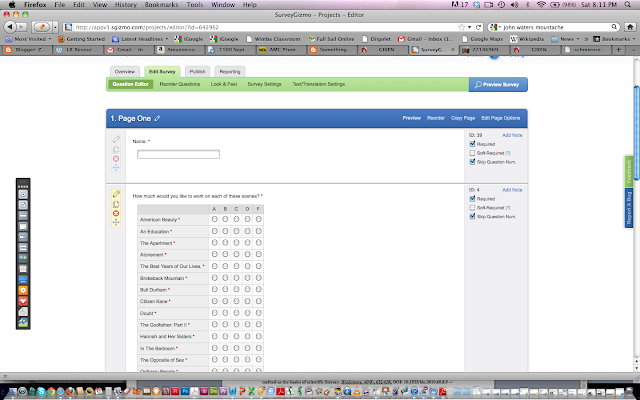Collecting Student Preference Information with Survey Gizmo
In our film program, with is 12 months long, The course they take in the 6th month is Film Production Two, for which I am the course director. It is commonly know as "midterms" and is essentially a practicum in which they put the skills they have learned in their sequence of core film making classes into practice. to students used to design their sets in the Art Direction class that precedes P2. Unfortunately, in the first year and a half of the program, the Art Direction teacher consistently resisted using the student groupings we made for P2 according to heterogeneous student centered distribution. She felt she needed to make her own distributions based purely on student selections.
This resulting in a number of problems such as the blind leading the blind scenario as discussed in a previous post along with multiple groups designing the same scenes resulting in a lack of diversity, as well as considerable confusion among the students.
This forced us to revise the program so that the design process was no longer integrated, so the students would not expect to build the sets they designed in Art Direction in P2. This is not at all optimal, as we do not have time in the production course for them to do adequate research and prep for their designs, so I have been trying to find a compromise that will allow the reintegration of the two courses.
What is most important for P2 organization is the diversity and balance of the skill sets in the groups. The selection of scenes is fundamentally a process designed to allow the students to feel ownership of the process and to insure that they have some passion for the material they work on. I decided I would allow the Art course to oversee the scene selection if they would respect my group selections, which they were happy to do since they were allowing student services to set the groups alphabetically to avoid the complexity of this sort of process. I am hoping they will look at this data set and not just allow the students to "pick", and this often involves what seem to me to be unjust social processes.
The process I have been using aggregates the preferences for the whole class to select the subset of top rated scenes, and then assign them to those crews based on their individual preferences. This has resulted in fairly consistent set of scenes each month, where the most well known and popular films always make the cut, with only a small variation among the last few scenes in the set. Using a sample from a smaller student set is likely to have more diversity.
So I will split the process to allow the formation of the groups based solely on rank, and then allow each group to select their scenes individually. This has the advantage of being likely to provide a wider variety of scenes as a small group is more likely to select what may be an outlying scenes as opposed to the whole class's valuation. The downside is that a democratic process may result in a scene being chosen that a minority of the members of the group dislike intensly. I tried adjusting the selections in various ways, and decided to weight the values for the grades so that minority opinion is better integrated. So I reset the return values to 4.5 for an A and -.5 for an F.
The student groups for Art this month were done in the usual way alphabetically by the studetn serv ices department, I augmented them based on GPA.
I plan to use the preference results from each set group, and aggregate them in this way. I've generated 15 test results from my original formula, and then generated fifteen more with the weighted values and compared them.
Here is the worksheet including the exported values for both sets of test data, with the weighted data highlighted in blue.
And here it is the weighted data inserted into my spreadsheet with the sum formulas and then sorted for preferences totals below. The top 12 highlighted in red, meaning that for this team, we would assign them to Some Like it Hot.
I need to get the results for my first round of surveys from the faculty as described in my last post, and then I can set the groups which I can then process with this data to arrive at the final scene groups.






No comments:
Post a Comment